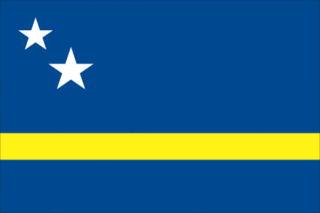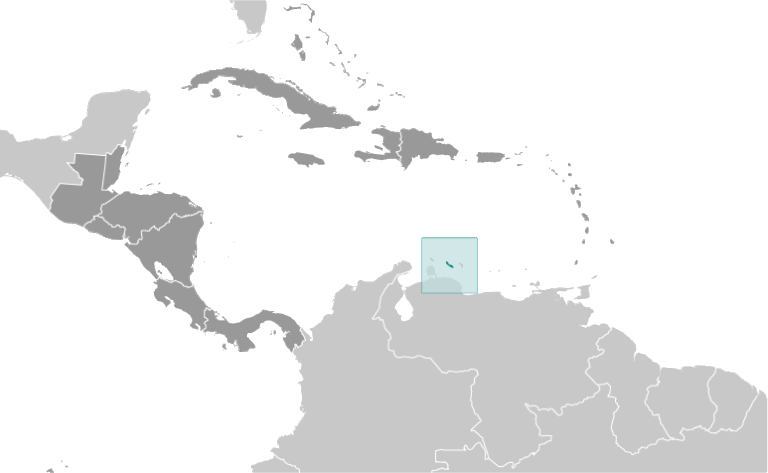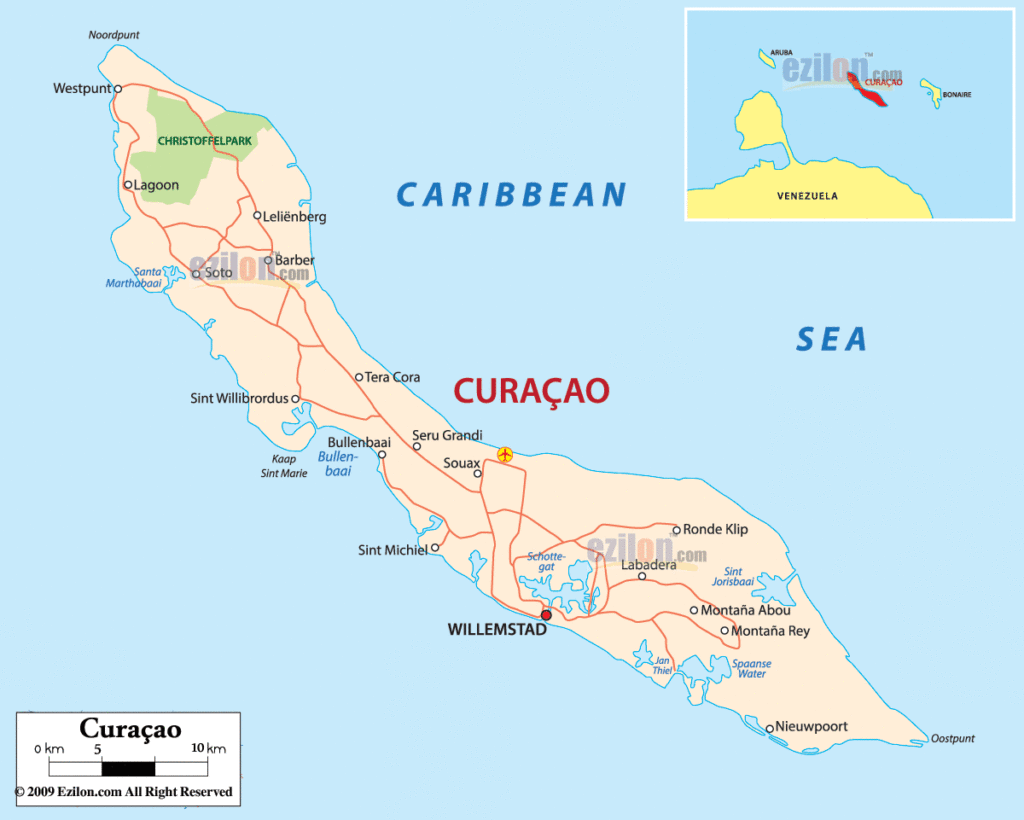Curaçao (/ˈk(j)ʊərəˌsoʊ, -ˌsaʊ, ˌk(j)ʊərəˈsoʊ, -ˈsaʊ/ KURE-ə-soh, -sow, -SOH, -SOW; Dutch: [kyːraːˈsʌu, kuːr-] (listen); Papiamento: Kòrsou, [ˈkɔrsɔu̯]), officially the Country of Curaçao (Dutch: Land Curaçao; Papiamento: Pais Kòrsou), is a Lesser Antilles island country in the southern Caribbean Sea and the Dutch Caribbean region, about 65 km (40 mi) north of the Venezuela coast. It is a constituent country of the Kingdom of the Netherlands. Together with Aruba and Bonaire, it forms the ABC islands. Collectively, Curaçao, Aruba, and other Dutch islands in the Caribbean are often called the Dutch Caribbean. It is the largest of the ABC islands in both area and population as well as the largest of the Dutch Caribbean.
Curaçao was formerly part of the Curaçao and Dependencies colony from 1815 to 1954 and later the Netherlands Antilles from 1954 to 2010, as Island Territory of Curaçao (Dutch: Eilandgebied Curaçao, Papiamento: Teritorio Insular di Kòrsou), and is now formally called the Country of Curaçao. It includes the main island of Curaçao and the much smaller, uninhabited island of Klein Curaçao (“Little Curaçao”). Curaçao has a population of 158,665 (January 2019 est.), with an area of 444 km (171 sq mi); its capital is Willemstad.
Location Maps
Where is Curacao?
High Definition Political Map of Curacao
History
Pre-colonial
The original inhabitants of Curaçao were the Arawak and Caquetio Amerindians. Their ancestors had migrated to the island from the mainland of South America, probably hundreds of years before Europeans first arrived.
Spanish colonization
The first Europeans recorded as seeing the island were members of a Spanish expedition under the leadership of Alonso de Ojeda in 1499. The Spaniards enslaved most of the Caquetios(Arawak) for forced labour in their Hispaniola colony, but paid little attention to the island itself. In 1515, almost all of the 2,000 Caquetios living there were also transported to Hispaniola as slaves.
Starting in 1499, Curaçao served as a bridge for the Spanish exploration and conquest of territories in northern South America. The Spanish settled on the island in 1527. Throughout the 16th century, they ruled Curaçao as an insular part of the province of Venezuela, governing it from the mainland before gradually abandoning it as colonization of the continent progressed. One of the oldest written references to the island is in the archives of the main public city registry of Caracas, Venezuela. A document dated 9 December 1595 states that Francisco Montesinos, priest and vicar of “the Yslas de Curasao, Aruba and Bonaire” conferred his power of attorney to Pedro Gutiérrez de Lugo, a Caracas resident, to collect his ecclesiastic salary from the Royal Treasury of King Philip II of Spain.
The Spanish introduced numerous tree, plant and animal species to Curaçao, including horses, sheep, goats, pigs and cattle from Europe and other Spanish colonies. In general, imported sheep, goats and cattle did relatively well. Cattle were herded by Caquetios and Spaniards and roamed freely in the kunuku plantations and savannas.
Not all imported species fared equally well, and the Spanish also learned to use Caquetio crops and agricultural methods, as well as those from other Caribbean islands. Though historical sources point to thousands of people living on the island, agricultural yields were disappointing; this and the lack of precious metals in the salt mines led the Spanish to call Curaçao “the useless island”.
Over time, the number of Spaniards living on Curaçao decreased while the number of aboriginal inhabitants stabilized. Presumably through natural growth, return and colonization, the Caquetio population then began to increase. In the last decades of Spanish occupation, Curaçao was used as a large cattle ranch. At that point, Spaniards lived around Santa Barbara, Santa Ana and in the villages in the western part of the island, while the Caquetios are thought to have lived scattered all over the island.
Dutch colonial rule
In 1634, during the Eighty Years’ War of independence between the Republic of the Netherlands and Spain, the Dutch West India Company under Admiral Johann van Walbeeck invaded the island; the Spanish surrendered in San Juan in August. Approximately 30 Spaniards and many indigenous people were then deported to Santa Ana de Coro in Venezuela. About 30 Taíno families were allowed to live on the island while Dutch colonists started settling there.
The Dutch West India Company founded the capital of Willemstad on the banks of an inlet called the Schottegat; the natural harbour proved an ideal place for trade. Commerce and shipping—and piracy—became Curaçao’s most important economic activities. Later, salt mining became a major industry, the mineral being a lucrative export at the time. From 1662, the Dutch West India Company made Curaçao a centre of the Atlantic slave trade, often bringing slaves from West Africa to the island, before selling them elsewhere in the Caribbean and Spanish Main.
Sephardic Jews fleeing persecution in Spain and Portugal sought safe haven in Dutch Brazil and the Dutch Republic. Many settled in Curaçao, where they made significant contributions to its civil society, cultural development and economic prosperity.
In the Franco-Dutch War of 1672–78, French Count Jean II d’Estrées planned to attack Curaçao. His fleet—12 men-of-war, three fire ships, two transports, a hospital ship, and 12 privateers—met with disaster, losing seven men-of-war and two other ships when they struck reefs off the Las Aves archipelago. The serious navigational error occurred on 11 May 1678, a week after the fleet set sail from Saint Kitts. To commemorate its narrow escape from invasion, Curaçao marked the events with a day of thanksgiving, which was celebrated for decades into the 18th century.
Many Dutch colonists grew affluent from the slave trade, building impressive colonial buildings in the capital of Willemstad; the city is now a UNESCO World Heritage Site.
In 1795, a major slave revolt took place under the leaders Tula Rigaud, Louis Mercier, Bastian Karpata, and Pedro Wakao. Up to 4,000 slaves in northwest Curaçao revolted, with more than 1,000 taking part in extended gunfights. After a month, the slave owners were able to suppress the revolt.
Curaçao’s proximity to South America resulted in interaction with cultures of the coastal areas more than a century after the independence of the Netherlands from Spain. Architectural similarities can be seen between 19th century Willemstad neighborhoods and the nearby Venezuelan city of Coro in Falcón State, which has also been designated a World Heritage Site. Netherlands established economic ties with the Viceroyalty of New Granada that included the present-day countries of Colombia and Venezuela. In the 19th century, Curaçaoans such as Manuel Piar and Luis Brión were prominently engaged in the wars of independence of both Venezuela and Colombia. Political refugees from the mainland, such as Simon Bolivar, regrouped in Curaçao.
During the 18th and 19th centuries, the British attacked the island several times, most notably in 1800, 1804, and from 1807 to 1815. Stable Dutch rule returned in 1815 at the end of the Napoleonic wars, when the island was incorporated into the colony of Curaçao and Dependencies.
The Dutch abolished slavery in 1863, causing vast changes in the economy with the shift to wage labour. Some Curaçao inhabitants emigrated to other islands, such as Cuba, to work in sugarcane plantations. Other former slaves had nowhere to go and continued working for plantation owners under the tenant farmer system, in which former slaves leased land from former masters, paying most of their harvest to owners as rent. The system lasted until the early 20th century.
Historically, Dutch was not widely spoken on the island outside of the colonial administration, but its use increased in the late 19th and early 20th centuries. Students on Curaçao, Aruba, and Bonaire were taught predominantly in Spanish until the late 17th century, when the British took all three islands. Teaching of Spanish was restored when Dutch rule resumed in 1815. Also, efforts were made to introduce widespread bilingual Dutch and Papiamentu education in the late 19th century.
20th and 21st centuries
When oil was discovered in the Venezuelan Maracaibo Basin town of Mene Grande in 1914, Curaçao’s economy was dramatically altered. In the early years, both Shell and Exxon held drilling concessions in Venezuela, which ensured a constant supply of crude oil to refineries in Aruba and Curaçao. Crude oil production in Venezuela was inexpensive. Both Shell and Exxon were vertically integrated and controlled the entire industry, from pumping, transporting, and refining to sales. The refineries on Aruba and Curaçao operated in global markets and were profitable partly because of the margin between the production costs of crude oil and the revenues made off of products. This provided a safety net for losses incurred through inefficiency or excessive operating costs at the refineries.
In 1929, Curaçao was attacked by Venezuelan rebel commander Rafael Simón Urbina, who, with 250 soldiers, captured the fort. The Venezuelans plundered weapons, ammunition, and the island’s treasury. They also managed to capture the Governor of the island, Leonardus Albertus Fruytier (1882-1972), and hauled him off to Venezuela on a stolen American ship, Maracaibo. Fruytier was criticized and had to resign as governor. After returning to the Netherlands, he settled for a position as chief inspector in Maastricht. The Dutch increased their military presence on the island.
In 1954, Curaçao and other Dutch Caribbean colonies were joined together to form the Netherlands Antilles. Discontent with Curaçao’s seemingly subordinate relationship to the Netherlands, ongoing racial discrimination, and a rise in unemployment owing to layoffs in the oil industry led to a series of riots in 1969. The riots resulted in two deaths, numerous injuries and severe damage in Willemstad. In response, the Dutch government introduced far-reaching reforms, allowing Afro-Curaçaoans greater influence over the island’s political and economic life, and increased the prominence of the local Papiamentu language.
Curaçao experienced an economic downturn in the early 1980s. Shell’s refinery on the island operated with significant losses from 1975 to 1979, and again from 1982 to 1985. Persistent losses, global overproduction, stronger competition, and low market expectations threatened the refinery’s future. In 1985, after 70 years, Royal Dutch Shell decided to end its activities on Curaçao. This came at a crucial moment. Curaçao’s fragile economy had been stagnant for some time. Several revenue-generating sectors suffered even more during this period: tourism from Venezuela collapsed after the devaluation of the bolivar, and a slowdown in the transportation sector had deleterious effects on the Antillean Airline Company and the Curaçao Dry Dock Company. The offshore financial services industry also experienced a downturn due to new U.S. tax laws.
In the mid-1980s, Shell sold its refinery for the symbolic amount of one Antillean guilder to a local government consortium. In recent years, the aging refinery has been the subject of lawsuits alleging that its emissions, including sulfur dioxide and particulate matter, far exceed safety standards. The government consortium leases the refinery to the Venezuelan PDVSA state oil company.
Continuing economic hardship in the late 1990s and early 2000s resulted in much emigration to the Netherlands.
On 1 July 2007, Curaçao was due to become a country within the Kingdom of the Netherlands, like Aruba and the Netherlands Antilles. On 28 November 2006, the change was delayed when the island council rejected a clarification memorandum on the process. A new island council ratified this agreement on 9 July 2007. On 15 December 2008, Curaçao was again scheduled to become a separate country within the Kingdom of the Netherlands. A non-binding referendum on the move was held in Curaçao on 15 May 2009; 52% of voters supported it.
The dissolution of the Netherlands Antilles came into effect on 10 October 2010. Curaçao became a country within the Kingdom of the Netherlands, with the kingdom retaining responsibility for defence and foreign policy. The kingdom was also tasked with overseeing the island’s finances under a debt-relief arrangement agreed upon between the two. Curaçao’s first prime minister was Gerrit Schotte. He was succeeded in 2012 by Stanley Betrian, ad interim. After the 2012 elections, Daniel Hodge became the third prime minister on 31 December 2012. He led a demissionary cabinet until 7 June 2013, when a new cabinet under the leadership of Ivar Asjes was sworn in.
Although Curaçao is autonomous, the Netherlands has intervened in its affairs to ensure that parliamentary elections are held and to assist in finalizing accurate budgets. In July 2017, Curaçaoan Prime Minister Eugene Rhuggenaath said he wanted Curaçao to take full responsibility over its affairs, but asked for more cooperation and assistance from the Netherlands, with suggestions for more innovative approaches to help Curaçao succeed and increase its standard of living. The Dutch government reminded the Curaçaoan government that it had provided assistance with oil refinery negotiations with the Chinese “on numerous occasions”.
The 2020 COVID-19 pandemic resulted in austerity measures. Curaçao had to impose spending cuts to qualify for additional aid from the Netherlands. As part of the austerity package, the Government of Curaçao announced a 12.5% cut in benefits for civil servants. On 24 June 2020, a group of civil servants, together with waste collectors from Selikor, marched to Fort Amsterdam and demanded to speak with Rhuggenaath. The demonstration turned into a riot, and police cleared the square in front of Fort Amsterdam with tear gas. The city centre of Willemstad was later looted. 48 people were arrested, the city districts of Punda and Otrobanda were placed under lockdown for the night, and a general curfew was declared from 20:30 to 06:00.


